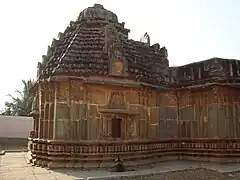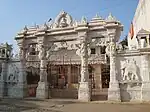| Lakshmeshwara Jain temples | |
|---|---|
 Shanka Basadi | |
| Religion | |
| Affiliation | Jainism |
| Deity | Neminatha, Anantanatha |
| Festivals | Mahavir Jayanti |
| Governing body | Shri Shankhabasadi Trust |
| Location | |
| Location | Lakshmeshwara, Gadag, Karnataka |
| Geographic coordinates | 15°07′37″N 75°27′51″E / 15.12694°N 75.46417°E |
| Architecture | |
| Style | Badami Chalukya architecture |
| Creator | Pulakeshin II |
| Date established | 7th century CE |
| Temple(s) | 3 |
The Lakshmeshwara Jain temples is a group of Jain temples in the town of Lakshmeshwara in the Gadag district of Karnataka.
History
Jainism as it relates to Lakshmeshwara has a long history.[1][2] Lakshmeshwara is one of the ancient Jain centres formerly known as Hugligare and Puligere.[3][4][5] Many Jain temples are mentioned in the inscriptions.[6][7][8] Kalyani Chalukyas' most important Jinalayas include Brahma Jinalaya at Lakkundi, Charantimatha at Aihole, and Sankha Jinalya at Lakshmeswar. The temple is believed to be an older structure than Meghuti temple.[1] The Sankha Jinalaya at Lakshmeshwara is dedicated to Neminatha. According to many inscriptions this was an important Jinalaya. Sendraka Durgashakti, a feudatory (vassal) of Pulakeshin II is said to have given gifts to this temple. There is an inscription in Shanka Basadi that mentions the temple received grants from Pulakeshin II in c. 609 – c. 642 CE.[9] An inscription by Vinayaditya (dated 686 A.D.) refers to a grant to the Jain Acharya of Devagana and Mulasangha.[6] An epigraph dated 723 CE, by Vijayaditya mentions a grant to Niravadya Pandita who was to house pupil of Sri Pujyapada. Another inscription of Vikramaditya II (dated 734 A. D.) mentions gifts to Shanka Jinalaya.[10] In 734–735 CE, Srivijayadevapanditacharya of dev gana received funds to make repairs to the temple.[11] Kunkuma Mahadevi, sister of Vijayaditya, constructed a large Jain temple during the reign of Kirtivarman II.[12] Lakshmeshwar was established as a Jain center by Chalukya dynasty and was further developed during Rashtrakuta period, having monuments from Rashtrakuta period.[1][7]
Adikavi Pampa wrote Ādi purāṇa, seated in this basadi (temple) during 9th century.[13][14]
Architecture
Shanka Basadi

Shanka Basadi is one of the two historical Jain temples at Lakshmeswar. The more famous temple is Sankha Jinalaya, also called Sahasrakuta Jinalaya, in the Basti Bana area. Shankha Jinendra(Neminath) (Shankha is the symbol of Neminath), the 22nd Jain Tirthankara (saviour), is the presiding deity of this Jain Basadi.[2] The temple derives its name from the image of Neminatha in kayotsarga posture standing on a large shankha (conch shell).[15] The Basadi consists of a garbhagriha (inner sanctum), a large ardhamandapa (porch), a larger mahamandapa (hall) and a ranga mandapa (pillared hall or pavilion ). The ranga mandapa has three entrances (south, north, and west). It has a chaturmukha (four-faced[16]) structure carrying three chaturmukha figures. The temple's shikhara is built in a rekhanagara style. The unique feature of this temple is a monolithic pillar with the carving of 1008 Tirthankaras known as Sahasrakuta Jinabimba.[17][18] There is a manasthamba (pillar) erected in front of the temple.[19][20] There are ventilated walls in front of the temple, whereas yakshas and yakshini are in the other walls.[21] There are many splendid carvings of dancers and musicians. Inside the temple, one can find the rare monolithic piece of Sahasra Jinabimbas (SahastraKut Jinalay) and the idols of Dharnendra and Padmavati. Many mutilated Jain idols are on the wall of a well nearby. The Basadi is in ruins and renovated; it represents the interest of the Kalyani Chalukyas in Jain architecture.[20]
Ananthanatha Basadi
Another Jain temple at Lakshmeshwara is the Ananthanatha Basadi, built-in c. 12th century CE, which is in the middle of the town. The temple is built using soap stone and features a phamsana style Shikhara.[22][23] The temple is constructed in Trikuta style and is an example of the Chalukya style of architecture.[20] The idol of Anantanatha, one of the 24 Tirthankars, is installed in the garbhagriha of the shrine.[21]
See also
References
Citations
- 1 2 3 Chugh 2016, p. 300.
- 1 2 Singh 2008, p. 26.
- ↑ Ben-Herut 2018, p. 348.
- ↑ Sharma 2009, p. 53.
- ↑ Subburaj 2003, p. 250.
- 1 2 Chugh 2016, pp. 300–301.
- 1 2 Karnataka Gazetteer Department, p. 69.
- ↑ Naik & Naik 1948, p. 79.
- ↑ Chugh 2016, p. 347.
- ↑ Singh 2008, p. 83.
- ↑ Singh 2008, p. 49.
- ↑ Chandrababu & Thilagavathi 2009, pp. 157–158.
- ↑ Azer 2011.
- ↑ Chugh 2016, p. 437.
- ↑ Shah 1987, p. 169.
- ↑ Ellis 2012, p. 202.
- ↑ Chugh 2016, p. 295.
- ↑ Chugh 2016, pp. 305–306.
- ↑ Ramaswamy 2017.
- 1 2 3 Chugh 2016, p. 306.
- 1 2 Vathsala 2019.
- ↑ Hardy 1995, p. 337.
- ↑ Britannica.
Bibliography
Books
- Ben-Herut, Gil (2018). Siva's Saints: The Origins of Devotion in Kannada according to Harihara's Ragalegalu. Oxford: Oxford University Press. ISBN 978-0-19-087886-3.
- Chandrababu, B. S.; Thilagavathi, L. (2009). Woman, Her History and Her Struggle for Emancipation. Chennai: Bharathi Puthakalayam. ISBN 978-81-89909-97-0.
- Chugh, Lalit (2016). Karnataka's Rich Heritage - Art and Architecture (From Prehistoric Times to the Hoysala Period ed.). Chennai: Notion Press. ISBN 978-93-5206-825-8.
- Hardy, Adam (1995). Indian Temple Architecture: Form and Transformation : the Karṇāṭa Drāviḍa Tradition, 7th to 13th Centuries. Kalāsamālocanā series. Delhi: Abhinav Publications. ISBN 978-81-7017-312-0.
- Ellis, Robert Richmond (2012). They Need Nothing: Hispanic-Asian Encounters of the Colonial Period. Toronto: University of Toronto Press. ISBN 978-1-4426-4511-0.
- Shah, Umakant Premanand (1987). Jaina-rūpa-maṇḍana: Jaina iconography. New Delhi: Abhinav Publications. ISBN 81-7017-208-X.
- Sharma, Ram Sharan (2009). Indian Feudalism, C. AD 300-1200 (3rd ed.). New Delhi: Macmillan Publishers. ISBN 978-1403-92863-4.
- Singh, Ram Bhushan Prasad (2008). Jainism In Early Medieval Karnataka. New Delhi: Motilal Banarsidass. ISBN 978-81-208-3323-4.
- Subburaj, V. V. K. (2003). Tourist Guide to South India (From Prehistoric Times to the Hoysala Period ed.). Chennai: Sura Books. ISBN 978-81-7478-175-8.
Web
- Azer, Rahman (27 June 2011). "Lakshmeshwar, a melting pot of cultures". Deccan Herald. Retrieved 9 May 2021.
- Vathsala, VP (18 May 2019). "Gadag Beckons". Deccan Herald. Retrieved 9 May 2021.
- Ramaswamy, Chitra (18 February 2017). "Karnataka, The Tourist Paradise". Millennium Post. Delhi. Retrieved 9 May 2021.
- Karnataka Gazetteer Department. "Karnataka, The Tourist Paradise" (PDF). Karnataka: The Gazette of India. Retrieved 9 May 2021.
- Britannica. "Phamsana". Encyclopædia Britannica. Retrieved 18 July 2021.
- Naik, A. V.; Naik, A. N. (1948). "Inscriptions of the deccan: an epigraphical survey (circa 300 b.c.-1300 a.d.)". Bulletin of the Deccan College Research Institute. 9 (1/2). JSTOR 42929414. Retrieved 9 May 2021.
External links
 Media related to Jain temple, Lakshmeshwara at Wikimedia Commons
Media related to Jain temple, Lakshmeshwara at Wikimedia Commons